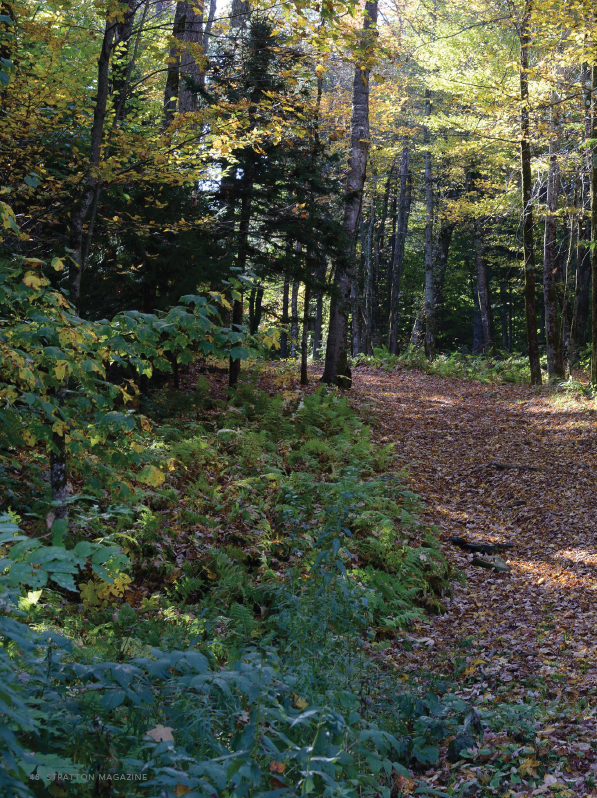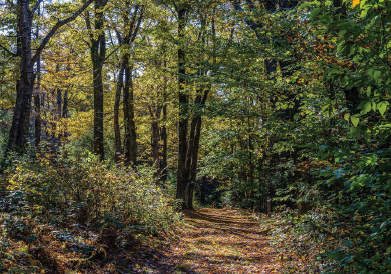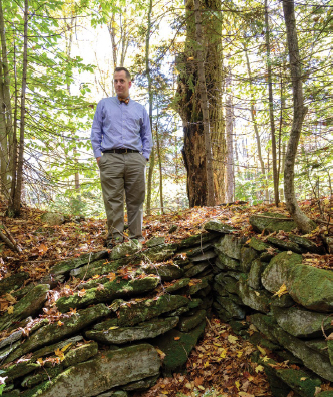By Luke Stafford
Photography By Hubert Schriebl
Exploring Vermont’s ancient roads takes enthusiasm for the mystique of the past
Thud, thud went the wheels of the pickup truck, first the front and then the back, as the road beneath us transitioned from pavement to dirt. I was in the passenger seat, admiring the views as we climbed a mountain. We were heading north on Rice Hill Road in Dover, Vermont. The punk rock band Bad Brains was playing on the stereo, loud enough to hear all the lyrics clearly but moderate enough to allow bursts of conversation with the man in the driver’s seat.
A few miles removed from the pavement, our dirt road began to resemble a quaint country lane. Unshorn roadside vegetation soon brushed the flanks of the pickup. Quaintness yielded to ruggedness. Bad Brains still blaring, I became acquainted with the handle above the door—the one typically reserved for injured, elderly or not-so-fit passengers needing assistance into the vehicle—as we slowed to 3 or 4 miles-per-hour, the pickup bobbing its way over potholes deep enough to host a child’s pool party.
 Soon we arrived at an intersection with a dry streambed. My driver seemed unfazed. “You’re going to cross that?” I asked in all seriousness. My Sherpa-for-the-day pushed the “4WD” button on the dash and replied, “I’ve done it before.”
Soon we arrived at an intersection with a dry streambed. My driver seemed unfazed. “You’re going to cross that?” I asked in all seriousness. My Sherpa-for-the-day pushed the “4WD” button on the dash and replied, “I’ve done it before.”
We made it another 400 yards before we intersected with another streambed. This crossing—born from the ravages of 2011’s Tropical Storm Irene, eight feet deep and 15 feet across—was not going to be crossed in any off-the-lot Toyota Tacoma. The truck stopped. The driver turned down the stereo, then instructed, “This is where we walk.”
Vermont is crisscrossed by hundreds of “ancient” roads. Officially, they are labeled as “Class 4 Town Highways or Legal Trails.” On one end of the spectrum, ancient roads can be well-maintained dirt roads, easily passable in a vehicle. In the middle, they are rugged and only passable via 4×4, ATV, or on foot and serve an important role as hiking and snowmobile trails for Vermonters and tourists. And on the opposite end of the spectrum, ancient roads have been completely reclaimed by forest, farmland or modern dwellings, nonexistent, save for the proof preserved in town vaults on yellowing, 150-year-old maps.
Cataloging Ancient Roads
In 2006, Vermont passed Act 178, which laid out an ultimatum for town officials: officially recognize and catalogue your ancient roads, or they will be lost forever. If the roads were not properly marked and included on the official town map by July 1, 2015, they lost authority as a public throughway and ownership was assumed by the adjacent landowner.
“I just think it’s cool to imagine what was going on here on this road 150 years ago. What did the landscape look like? Who is buried at that grave?”
–Spencer Crispe
Spencer Crispe, my guide for the day, isn’t sure if the town has officially mapped the road we’re now walking on. He’s not so much into the politics of Vermont’s ancient roadways; he is interested in the landscape and history. “I’m a nerd when it comes to poring over old maps,” confesses Crispe. “I just think it’s cool to imagine what was going on here on this road 150 years ago. What did the landscape look like? Who is buried at that grave?”
Crispe perhaps has more reason to wonder about Vermont’s 19th century history than the rest of us; he is a seventh generation Vermonter with deep roots in the southeast corner of the state. His grandfather, Luke Crispe, was a founder of Stratton Mountain and a Republican candidate in the 1960 Vermont gubernatorial race. But it was Crispe’s grandmother, an avid genealogist who passed away last year at age 98, who originally got him into local history. “I caught the bug from her, for sure,” smiles Crispe.
“Does this road even have a name?” I ask, trailing a few feet behind Crispe as we maneuver around a large puddle. He shrugs.
“I know International Paper owned a ton of land up here for making paper. It’s Green Mountain Forest land now.” We’re both on the lookout for an old stone foundation in the earth. Those that hunt them call these relics cellar holes, and they’re usually set back several dozen feet from the ancient roads. Some cellar holes remain wonderfully preserved.
Others are buried under a century of changing seasons, invisible. Crispe stumbled across one a few years ago, and he wants to show me “something really cool.” We plod along the overgrown road, which is still wide enough to accommodate a modern vehicle, but much too rugged. In spots, you can even make out old wheel ruts. Century-old stonewalls, still very much intact, border the road. They gradually lose their virility as we move eastward, sometimes disappearing into the earth, only to resurface a few hundred feet later. Crispe explains that, if you’re lucky, you sometimes stumble upon centuries-old, unmarked graveyards that “are a treasure to find.”
Land Cleared for Sheep
Although we haven’t seen a soul or dwelling since we left the paved road, Crispe tells me that this area was actually well populated in the mid to late 1800s. Back then, there was a healthy economy supported by a booming wool industry, and much of the forest around us was cleared to support huge flocks of Merino sheep. Pioneering spirits cut down trees, moved tons and tons of rocks (hence the rock walls and stone foundations) and built roads and houses, all before the age of the internal combustion engine. “I don’t think we can fully appreciate the independence and isolation that people had back then,” Crispe ruminates. And it’s very likely that the road under our feet is much older than 150 years. It may have started as a migratory path for deer, a logical and natural way to get from one mountain to the next. Then, millennia ago, Native Americans trod the path into a walking trail. European settlers arrived, thinking, “Why build a new road when we can simply improve upon this one?”
Almost a mile into our walk, Crispe spots his cellar hole. He is visibly excited by the find, and bushwhacks to the spot. We both stand at the lip of the foundation for a moment, surveying. We are quiet. Although there are no tombstones in sight, it is obvious that both of us are paying respect to the lives that once called this patch of earth home. I try to imagine it without the birch trees growing around the rim and the moss lining the inner walls. I wonder, was it a simple log home built on this foundation, or a white farmhouse? How many generations lived here? Crispe interrupts my thoughts. “This isn’t it.” We are at the wrong cellar hole.
Turning to walk back to the road, Crispe feels something solid underfoot, juxtaposed against the soft moss. I help him clear decades of decayed leaves and together we pull up a large sheet of metal. I kick off some more dirt and discover what we are holding: a rusty old 1930s pickup truck door. This is not the “something” really cool that Crispe had in mind, so we continue north.
Hiking Ancient Roads
Walking, I learn that Crispe spends almost every weekend in hiking boots. He’s summited every major mountain in Vermont, even the ones with no trails that require bushwhacking and lots of deet. He has hiked nearly all the ancient roads that still exist in Windham and Bennington counties. Before heading out, he consults his trusty McClellan’s map of Windham County, originally published in 1856. Sometimes he’ll use the Beers atlas from the late 1800s. He typically navigates with a map and compass. On weekdays, the hiking boots get a rest and Crispe dons a bowtie and slacks at the offices of Crispe and Crispe, practicing law in the tradition started by his great-grandfather in 1914. He works alongside his father, Lawrin Crispe, at the firm.
“Roads, once laid out, never fade away, never are abandoned by neglect or non-use or lose their official character, even if nothing of them remains except a musty record in a book in the town clerk’s office. With highways, what was once is forever.”
–Paul Gillies
 I learn that a big portion of his business as an attorney is real estate. This means he’s logged hundreds and hundreds of hours searching titles in town clerk vaults, checking to ensure that his clients don’t have obscure liens on the property they’re about to purchase. It also means that maps must be carefully reviewed and property lines accurately noted. Sometimes, it means tracing the history of ancient roads that may, or may not, still exist as a public highway on private land. With so much time spent poring over these maps, there aren’t many people on earth who know the ancient roads of Southern Vermont better than Crispe.
I learn that a big portion of his business as an attorney is real estate. This means he’s logged hundreds and hundreds of hours searching titles in town clerk vaults, checking to ensure that his clients don’t have obscure liens on the property they’re about to purchase. It also means that maps must be carefully reviewed and property lines accurately noted. Sometimes, it means tracing the history of ancient roads that may, or may not, still exist as a public highway on private land. With so much time spent poring over these maps, there aren’t many people on earth who know the ancient roads of Southern Vermont better than Crispe.
After another 15 minutes of hiking, we do a U-turn. Crispe figures we must have passed the cellar hole, but it’s very close. He veers right, crashing through bushes, and begins walking parallel to the road. “I know it’s right around here,” he shouts to me. I put in a half-hearted effort to join him in the prickly roadside flora, searching, but the comfort of the road calls me back. “Yes!” I hear from the bushes. “I knew it!” Crispe has discovered the cellar hole. I quickly push through the underbrush and come upon the beautifully preserved specimen. It is L-shaped, with a 7-foot-high wall wrapping around the outside of the foundation-turned-artifact. I hop down inside and walk along the wall, brushing the moss on the rocks with my hand. “You ready for the surprise?” asks Crispe.
We climb up out of the hole and take a seat next to a flat rock. It looks like any other rock around us, but Crispe is focused on it for some reason. He asks me to pick it up. “Um, okay,” I reply, wondering how this could possibly be part of the cool surprise. Hefting it up, I discover that there is a jar beneath it. Smiling, Crispe gingerly picks up the jar and unscrews the lid. Inside is a folded mass of papers, damp and stuck together. We each take half and I follow Crispe’s lead, very gently separating the papers. I realize that I’m holding some very old handwritten letters. The dates at the top of each letter vary widely, from the 1920s to the 70s. Continuing through the pile, I find old ticket stubs and baseball cards. Crispe points out that the last names on the letters are consistent with the family that, according to Crispe’s research and best guesses, once lived at the cellar hole. I realize that we’re holding a family time capsule, updated over the decades with new treasures. Most of the material is degraded or faded beyond decipherability. But I find one business card-sized ticket stub that has retained its luster for almost 80 years: a ticket for “Dance Music by Joe Venner’s Band at the Arcadia Ballroom.” The price, good for a Saturday evening show on September 30, 1939, was $.05.
I pressed, but Crispe wouldn’t tell me how he originally discovered the time capsule. I stress more than once that the odds of him accidentally stumbling upon it are astronomically low, and he agrees, smirking. Then I remember that he stumbled upon that old pickup truck door, buried beneath several inches of dirt and moss, an hour before. Rather than interrogate him for more details and spoil the moment, I chalk it up to the sixth sense of an ancient road wanderer. We return the letters to the jar, screw the lid on and put the rock back in place. We spend a few more minutes appreciating the cellar hole, turn south, and walk back to the pickup truck.
After our day in the woods, I learn that there are many other Vermonters who share Crispe’s passion for unlocking the mysteries in our ancient roads. Since Act 178 passed almost a decade ago, enthusiasts all over the state have volunteered to preserve their status. I find one other man—another attorney, based in Montpelier, named Paul Gillies—who sums up the mystique of ancient roads beautifully: “He knew that roads, once laid out, never fade away, never are abandoned by neglect or non-use or lose their official character, even if nothing of them remains except a musty record in a book in the town clerk’s office. With highways, what was once is forever.” ◊
Luke Stafford is a freelance writer and owner of Mondo Media Works in Newfane.


